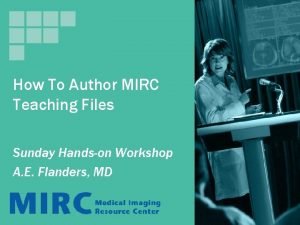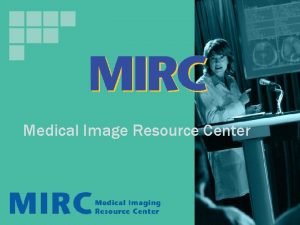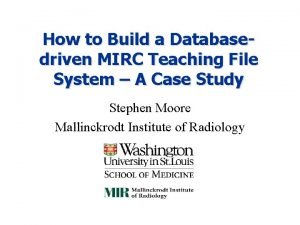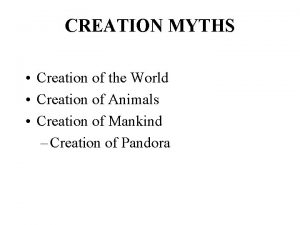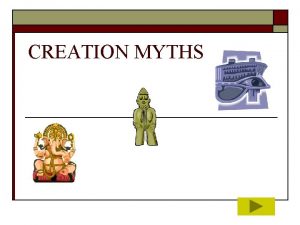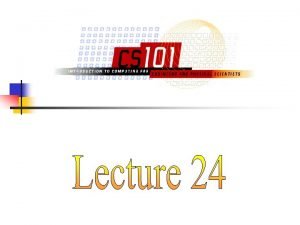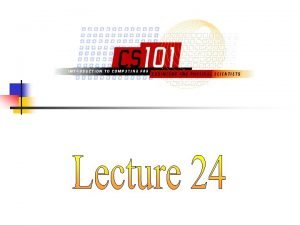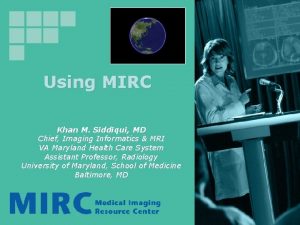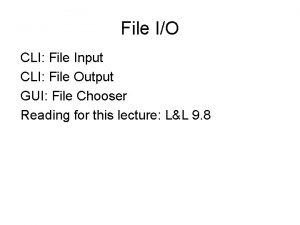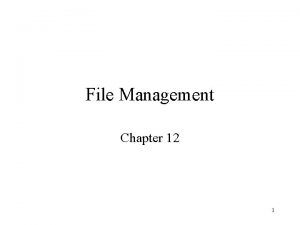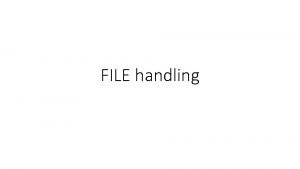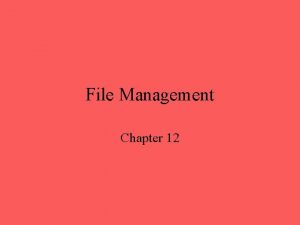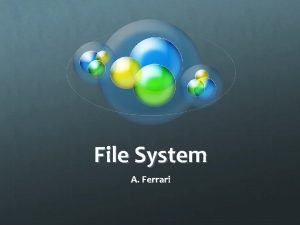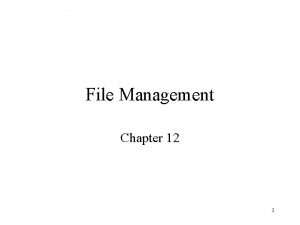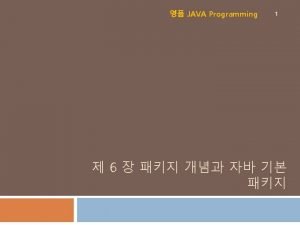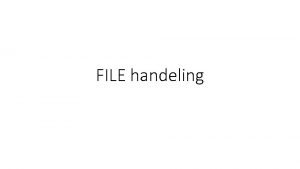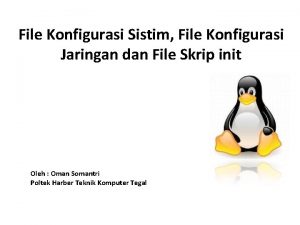Teaching File Creation with MIRC Using MIRC for


















































![Let’s Log in…. Username: user + [1 – 20] n Password: user n Let’s Log in…. Username: user + [1 – 20] n Password: user n](https://slidetodoc.com/presentation_image_h2/552deaff08f7a66e1c5ac6242bcfd022/image-51.jpg)





- Slides: 56

Teaching File Creation with MIRC Using MIRC for Departmental Teaching Files Adam E. Flanders, MD Thomas Jefferson University Hospital Philadelphia, Pennsylvania

Segment Objectives Features of a digital teaching file. n The MIRC solution n MIRC authoring. n

What is a Teaching File? An organized repository of clinical images and documentation. n Used primarily to supplement learning process for trainees. n Source material for lectures, publications. n Film library model n Shelves of cases (film jackets) n Organized by anatomy, disease, ACR codes. n

What are the Qualities of a “Great” Radiology Teaching File ü ü High quality Images Comprehensive supplemental Information: ü ü ü ü path reports, path images, discussion etc. Organization Indexed and searchable Fresh content. Easily accessed from anywhere. Easy to navigate. Secure

Problems with Film-Based TF n n Limited access. Typically, a lot of work to submit a case. n n Difficult to keep organized. n n n Difficult to solicit “voluntary” contributions. Missing or misfiled cases or films. Need a librarian/policeman Securing files = limited access. Searching file is problematic. Inconvenient to use for decision support. Difficult to update/maintain – keeping material current.

Analog to Digital Transformation Inexpensive digital cameras / scanners. n Retirement of hard copy (film) n Proliferation of PACS. n Proliferation of workstations. n

Digitizing Analog Images

Digitizing Analog Images Digital Camera on PACS or Viewbox Laborious but effective!

Personal Image Storage Solutions

Digitized Images: Big Step Forward! n Advantages n n n Lightweight and reusable No deterioration, loss, resistant to theft. Modifiable Easy to adjust, crop, contrast, brightness Easy to add annotation. Problems n n Access remained limited. Organization! Large collections, difficult to find images without meticulous labeling methods Sharing material?

Where to Put Your Images? - Personal DTF n n Copy images into folders labeled appropriately. Nested file structure Need to open content in another application for use. Not very versatile

Personal Teaching Files n n n n Thousands of radiologists have amassed “personal” collections of images. Solutions include cases on email, upload of cases to free digital photo services (ie Google, Flikr, Picassa, Shutterfly etc. ) Generally used by a single user. Accessible from a single computer Image collections are limited in scope. Difficult to enhance content. Not readily sharable

Personal DTF Organization with Picassa

The Next Phase n n Web browser is the most appropriate vehicle for delivery of educational content. Browsers are designed to display written and visual content efficiently. Including multimedia. Early DTF contained “static” web pages. n n n Laborious to produce. Time consuming to update and index. Modern DTF coupled to a database generates content dynamically (“on-the-fly”). n n Easier to modify More conducive to search mechanisms

Components of a Modern DTF Fileserver n Database n Webserver n Fileserver Database Ethernet Webserver

What Do People Want? Radiologists want a simple method to create teaching materials from their existing PACS systems. n Ease of use n Time efficient n Simple to access n Scalable in terms of size & complexity. n

What Is Available NOW? n Commercial turnkey systems available for a price which will provide: Method to save images & data from PACS. n Storage local or off-site for your cases n Web server to display cases n Organizational repositories (e. g. ACR Case-In-Point, Aunt Minnie, My. PACS etc. ) n You can develop your own… n Or there is MIRC!!!! n

What Does The MIRC Software Suite Do For Me? Medical Imaging Resource Center

Da’ Answer Set of software tools that allow you to create, index, search and display teaching materials. n Repository for educational content. n n n Including peer review content (via RSNA). Ability to selectively share this material in a consistent manner within your institution on your local intranet or worldwide on the internet.

MIRC factoids n n An RSNA sponsored initiative. Software toolkit that can be used for creation of teaching repositories and clinical trials databases. Built on open-source principles. No proprietary technology. n n Uses available standards DICOM, XML, HTTP, JSP, Java Software is free-of-charge, no licensing. Software designed to operate on most common operating systems incl. Windows, Apple OSX and Linux. PACS vendor neutral.

MIRC Components n Web server n File server n Self updating index n Powerful administrative functions

MIRC Features Ø Ø Ø Individualized file storage Multiple document “templates” Multiple methods to author content Multiple methods to display content Web-based DICOM viewer. Web-based editor. DICOM receiver (DICOM SCP) DICOM anonymizer Administrative control of viewing, editing, deletion. Scalable and expandable from one author/PC to hundreds. Easy to install & configure. Many more…

Scalability of MIRC n n MIRC has the unique ability to scale from one computer / one user to many computers / many users. Potential configurations include: n n n One MIRC repository for one or more users. Multiple MIRC repositories in one or many institutions. Software enables development of cooperative libraries. n Each library is individually administered yet portions can be made accessible to all.

MIRC supports all information storage formats. n Images: DICOM, GIF, JPEG, PNG n Hyperlinks to other web content. n Virtually any content that is displayable in a web browser. n Pointers to other files for downloading. n Display support for other types in the future…

MIRC TF Configuration Scenarios n Private Mode n Departmental Mode n Division Mode n Worldwide Mode n Variations

MIRC TF Scenarios Private (selfish) Mode n n n Single-user contributor Single-user access No sharing of content My Stuff

MIRC TF Scenarios Divisional / Semi-Private Mode n n n Each division or key individual maintains a server. Division is responsible for maintaining their content. All or a portion of content can be made public. Any individual can access public records on other MIRC servers within institution. Much more difficult to administer.

n n n n Multiple users or divisions contribute to a single departmental MIRC server. All users have controlled access. All can view public cases. Only owners can modify data. Private cases are supported. One server to manage for all content. Easier to administer. MIRC TF Scenarios Departmental Mode Neuro MSK Neuro NM Chest Mammo CT Body MR Mammo CVIR MSK Private BIG MIRC User

MIRC TF Scenarios Worldwide Mode Internet n n Multiple MIRC sites (“MIRClets”) expose content to the Internet. This public content is accessible to other computers that can perform a query of MIRC content.

The MIRC Authoring Process

Four Ways to Author Basic authoring tool. n Advanced authoring tool. n Submit Service n ZIP Service n

Three Kinds of Authoring n Point-of-care n. Bookmarking n Retrospective n Combination

Getting Images to MIRC

Storing Images in MIRC software was designed to utilize common features available by most PACS vendors to export images. DICOM SCU/SCP (i. e. DICOM export) n Saving images locally to PACS desktop or folder (subdirectory) n n Images are uploaded to the MIRC file service in one of three ways:

Storing Images in MIRC n 3 Methods DICOM export n Upload single image n Upload multiple files (using ZIP archive) PACS n DICOM Export ZIP File Single Image

MIRC File Service Individualized file browser for each registered user Container for images. File Service Function Buttons n Two File Storage Areas n • Add Files Public • Delete Files n Private • Update Name n Other File Types by Name Can • Find Transfer Files Between Public • Export File to Desktop and • Private Repositories. Copy to Public (shared files) Native DICOM n Delete, Add or Update files to. Support the File Service. n

n n n From DICOM SCP or copied from personal file cabinets Files in the shared file cabinet are available to all users. Select one or more images. Copy to personal file cabinet. Begin submission process.

ZIP Service Method to convert an existing teaching file system to MIRC from a conventional teaching file hierarchy. n This will bulk convert all your images that are in folders in a hierarchical structure to MIRC. n Supplement information as needed. n Is a great way to get started with MIRC! n

TCE Service n n n The TCE service is an implementation from the Teaching Files and Clinical Trials Export Integration Profile from IHE. Brings point-of-care authoring to all PACs users. Enables one to author teaching file cases directly from PACS. n n Select key images. Add pre-defined text elements. Submit directly to your MIRC service. This closes the loop for efficient authoring.

TCE Service n Four PACS vendors support and have working demonstrations of the TCE export profile at RSNA 2006 & 2007. Agfa n Fuji n GE n Vital Images n n Come see the demonstration in LLC and in technical exhibits area on a real PACS system.

Powerpoint Tool n n There is a handy (free) Powerpoint add-in which will take an entire presentation and convert each slide to a MIRC TF document. Many people use Powerpoint as their teaching file repository; this is another way to convert to MIRC. Add-in has been revised, is easy to use and install. Available on the MIRC Wiki.

MIRC Wiki All of the MIRC documentation has been uploaded to a new Wiki site which is easy to navigate and search. n All docs and downloads available there. n

Explore the MIRC Software

Tasks for Today n n n n Logon to Local RSNA MIRC site. Explore the image file cabinet. Perform a basic authoring with a few images and text. Edit our case with the advanced authoring tool. Add annotations, captions, text. Preview our case. Publish. Query our cases on the RSNA server.

To Begin n Double click on the MIRC icon on your desktop to launch your browser on the MIRC server

MIRC Front Page

Let’s Look Around

Let’s Look Around

Authoring Sequence for Today n n Login Explore the File Cabinet n n Copy images to personal cabinet Add, delete, copy n n Launch Basic authoring page. Upload one or more images from directory. Basic Authoring Edit Case on Advanced Tool n n n n Explore advanced tool Add more text. Annotate images Add images Preview case. Publish!!! Query the site to see the collective work!!!

Let’s Author
![Lets Log in Username user 1 20 n Password user n Let’s Log in…. Username: user + [1 – 20] n Password: user n](https://slidetodoc.com/presentation_image_h2/552deaff08f7a66e1c5ac6242bcfd022/image-51.jpg)
Let’s Log in…. Username: user + [1 – 20] n Password: user n

Functions to Focus On n These tools appear once you’re logged on to system. These are all on the left side of the query page. Concentrations n n n Basic authoring Advanced authoring File Cabinet


What Are My Options? n n What if you would like to explore the MIRC software, but don’t want to have to set up your own system? My. MIRCFiles 2008 n n RSNA is offering to all members an open MIRC repository to store all of your materials. Utilizes the MIRC software. Any RSNA member can use it for FREE! Gives you an opportunity to “kick-the-tires” before you commit to building your own.

What About PACS Interfaces? MIRC software is vendor neutral. n Therefore it tries to adhere to existing or upcoming standards. n The TCE profile is getting more attention from PACS vendors. n This will allow you to send directly from PACS using key images. n n Obviate the need to open a web browser to author cases.

More Information n Check out the MIRC Wiki: n http: //mircwiki. rsna. org Look over your handout & syllabus. n A full installation of MIRC software with documentation is on the CDs. n
 File-file yang dibuat oleh user pada jenis file di linux
File-file yang dibuat oleh user pada jenis file di linux Medical query
Medical query What is mirc
What is mirc Care for god's creation catholic social teaching
Care for god's creation catholic social teaching Difference between logical file and physical file
Difference between logical file and physical file Fungsi dari create file pada operasi-operasi file (cont.)
Fungsi dari create file pada operasi-operasi file (cont.) Distributed file system definition
Distributed file system definition An html file is a text file containing small markup tags
An html file is a text file containing small markup tags In a file-oriented information system, a transaction file
In a file-oriented information system, a transaction file Meaning of micro teaching
Meaning of micro teaching Hadoop io hadoop comes with a set of
Hadoop io hadoop comes with a set of Iso 22301 utbildning
Iso 22301 utbildning Novell typiska drag
Novell typiska drag Nationell inriktning för artificiell intelligens
Nationell inriktning för artificiell intelligens Returpilarna
Returpilarna Varför kallas perioden 1918-1939 för mellankrigstiden
Varför kallas perioden 1918-1939 för mellankrigstiden En lathund för arbete med kontinuitetshantering
En lathund för arbete med kontinuitetshantering Personalliggare bygg undantag
Personalliggare bygg undantag Vilotidsbok
Vilotidsbok Anatomi organ reproduksi
Anatomi organ reproduksi Densitet vatten
Densitet vatten Datorkunskap för nybörjare
Datorkunskap för nybörjare Stig kerman
Stig kerman Debatt artikel mall
Debatt artikel mall Delegerande ledarskap
Delegerande ledarskap Nyckelkompetenser för livslångt lärande
Nyckelkompetenser för livslångt lärande Påbyggnader för flakfordon
Påbyggnader för flakfordon Tryck formel
Tryck formel Publik sektor
Publik sektor Kyssande vind
Kyssande vind Presentera för publik crossboss
Presentera för publik crossboss Argument för teckenspråk som minoritetsspråk
Argument för teckenspråk som minoritetsspråk Kanaans land
Kanaans land Treserva lathund
Treserva lathund Fimbrietratt
Fimbrietratt Bästa kameran för astrofoto
Bästa kameran för astrofoto Cks
Cks Lågenergihus nyproduktion
Lågenergihus nyproduktion Mat för unga idrottare
Mat för unga idrottare Verktyg för automatisering av utbetalningar
Verktyg för automatisering av utbetalningar Rutin för avvikelsehantering
Rutin för avvikelsehantering Smärtskolan kunskap för livet
Smärtskolan kunskap för livet Ministerstyre för och nackdelar
Ministerstyre för och nackdelar Tack för att ni har lyssnat
Tack för att ni har lyssnat Referat mall
Referat mall Redogör för vad psykologi är
Redogör för vad psykologi är Stål för stötfångarsystem
Stål för stötfångarsystem Tack för att ni har lyssnat
Tack för att ni har lyssnat Borra hål för knoppar
Borra hål för knoppar Orubbliga rättigheter
Orubbliga rättigheter Standardavvikelse
Standardavvikelse Tack för att ni har lyssnat
Tack för att ni har lyssnat Rita perspektiv
Rita perspektiv Verksamhetsanalys exempel
Verksamhetsanalys exempel Tobinskatten för och nackdelar
Tobinskatten för och nackdelar Blomman för dagen drog
Blomman för dagen drog Modell för handledningsprocess
Modell för handledningsprocess

